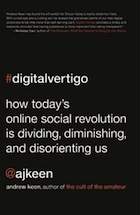
RATING: 8/10
While many are championing the social media revolution, Andrew Keen urges us to take a step back and remove the blinders. Instead of connecting us, Social Media he argues is dividing us and making us more lonely–observers in a mob, rather than active participants. It is a book that cuts through all the Silicon Valley BS of the social economy being the new future.
Notes:
Personal visibility, I recognized, is the new symbol of status and power in our digital age. Like the corpse locked in his transparent tomb, we are now all on permanent exhibition, all just images of ourselves in this brave new transparent world.
In this fully transparent world where we are simultaneously nowhere and everywhere, absolute unreality is real presence, and the completely fake is also the completely real.
In Nineteen Eighty Four, it was a crime to express yourself; today, it is becoming unfashionable, perhaps even socially unacceptable not to express oneself on the network.
The problem is more cultural than technological. We live in an age of self-loathing in which everyone is part of counterculture.
Everyone is now a joiner but not an active participant.
On Twitter, for example, only 0.05 percent of people have more than 10,000 followers with 22.5 percent of users accounting for 90 percent of activity, thus reflecting the increasingly unequal power structure of an attention economy in which the most valuable currency is being heard above the noise.
To ourselves, we are special people, documented in wonderful photos, and it also happens that we buy things…To the advertisers, we are our capacity to buy, attached to a few personal relevant photos.
It is ironic that the people who complain most loudly that people cannot relate to one another, or cannot communicate are often the very sample people who urge grater individuality. Thus, as Toffler noted, postindustrial man is “modular man.” Able to create a diversity of “temporary interpersonal relationships” that precludes us—in contrast with out preindustrial ancestors—from a strong sense of community and identity. “For just as things and places flow through our lives at a faster clip, so too do people.
Behind the communitarian optimism of the digital utilitarian’s lies a vertiginous and social fragmented twenty first century truth. It’s a postindustrial truth of increasingly weak community and a rampant individualism of super nodes and super connectors. It’s the truth of an “attention” economy that used individual “reputation” as its major currency on networks like Klout. And, most troubling of all, it’s the antisocial truth of socioeconomics world of increasing loneliness, isolation and inequality—a socially dysfunctional condition that Sherry Turkle describes as being “along together.”
Their nostalgia for the simple community of the Middle Ages—not unlike Marshall McLuhan’s idealization of the oral culture of primitive man, or Clay Shirky’s and Robert Putnam’s romanticized versions of participatory democracy in pre-twentieth century communal life—was an invention that bore little, if any, actual truth to the past. This retreat into an idealized picture of the past that was, as Laurence de s Cars notes in his study of the Pre-Raphalites, “A away of replacing the realities of modern life with romance and chivalry.
We see human beings turned inside out, so that all their most intimate data is displayed in the full gaze of the public network. We see a reputation economy in which respect, love, friendship and trust are replacing cash as society’s scarcest and thus its most valuable commodity. We see a Super Sad True Love Story featuring global super noses with millions of friends who don’t know the names of their neighbors. We see digital vertigo. More and more digital vertigo.
Scoble, I realized represented a future that neither @quixotic nor I could clearly see in our Oxford debate. Scoble’s initialized, personalized community—a peculiar synthesis of the cult of the individual and the cult of the social—offered the answer to how social media communities might eventually replace the nation state as the source of identity in the twenty first century. In the nineteenth and twentieth centuries, Ernest Gellner reminds us, individuals were united into physical communities by common languages and cultures; today, the community is becoming a reflection that individual. Scoble’s social media community was therefore, an extension of his self, a never ending hall of mirrors all reflecting the same opaque image of Scoble—which explained why, in spite of his self-styled openness and good cheer, he seemed so solitary and lost, so creepily childlike, so much like Truman Burbank. Living within his enclave within an enclave, simultaneously connected with everybody and nobody, his story, The Scoble Story, so to speak, is a sneak preview of how we will live alone together in the perpetually impermanent twenty first century.
As John Stuart Mill argues in On Liberty, government exists to protect us from others rather from ourselves and the reality, for better of worse, is that once a photo, an update or a tweet is publicly published on the network, it becomes de facto public property. So, without wishing to sound too much like the uber glib Eric Schmidt, the only way to really protect one’s own privacy is by not publishing anything in the first place.
Her authenticity lies in her mystery, not in her nakedness.
